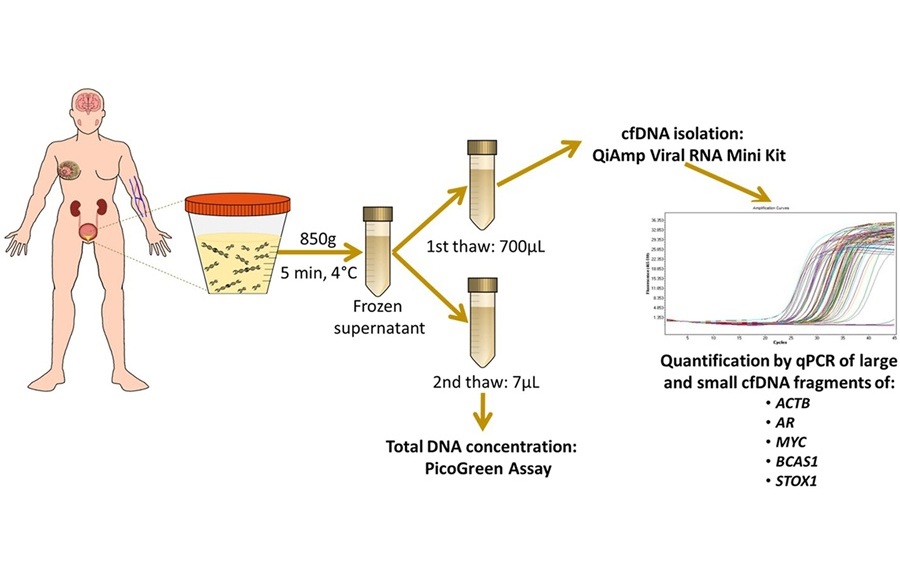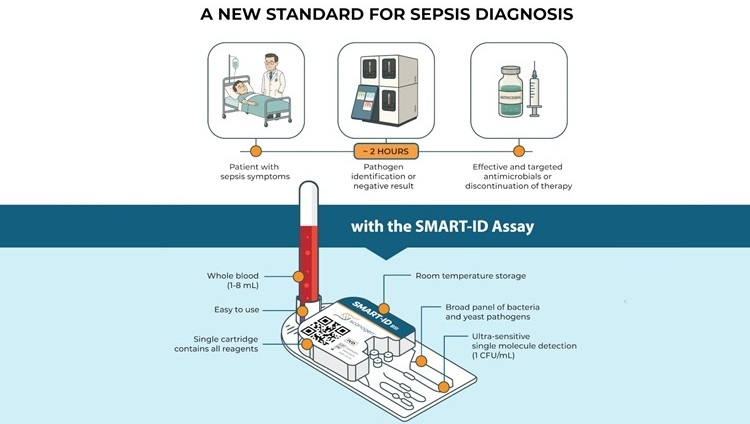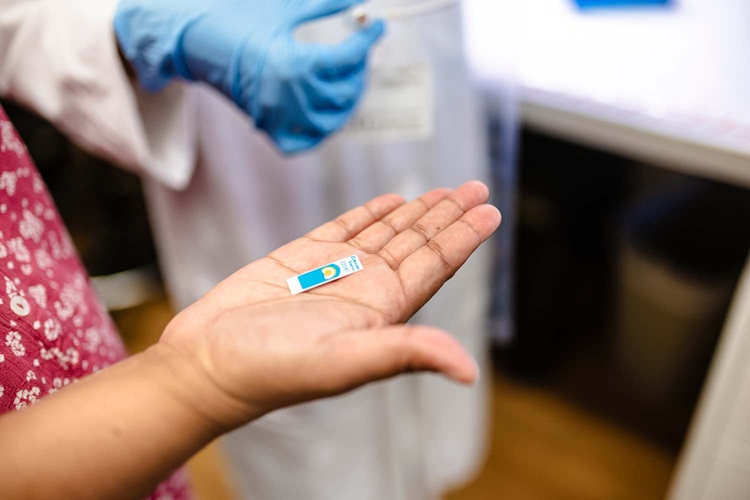Blood Test Distinguishes Epileptic Seizures From PNES
|
By LabMedica International staff writers Posted on 16 Feb 2021 |

Image: An association of epileptic and non-epileptic seizures and changes in circulating plasma proteins is linked to neuroinflammation (Photo courtesy of Evogen, Inc).
Epilepsy is a central nervous system (neurological) disorder in which brain activity becomes abnormal, causing seizures or periods of unusual behavior, sensations, and sometimes loss of awareness. Epilepsy affects both males and females of all races, ethnic backgrounds and ages.
Epilepsy affects over 70 million people worldwide. This common brain condition has multiple risk factors and a strong genetic predisposition. Psychogenic non-epileptic seizures (PNES) are events resembling an epileptic seizure, but without the characteristic electrical discharges associated with epilepsy. They are of psychological origin, and are one type of non-epileptic seizure mimicked.
Neuroscientists from the University of Maryland (Baltimore, MD, USA) and their colleagues collected daily blood samples from patients evaluated in the epilepsy monitoring unit (EMU) within 24 hours after electroencephalograms (EEG) confirmed epileptic seizures (ES) or PNES and plasma was isolated. A total of 137 patients were evaluated in the EMU for differential diagnosis or pre-surgical evaluation; 29 healthy volunteers also were prospectively enrolled in the study in 2014-2015. Of the 137 initially enrolled patients, 48 were excluded because no definitive diagnosis could be made. Timing of blood draws excluded another 42 patients, leaving 23 epilepsy patients (65.2% women, mean age 44) and 24 PNES patients (79.2% women, mean age 44). Multiple races and ethnicities were represented.
The scientists quantified the levels of 51 candidate plasma proteins using an automated, multiplexed, sandwich enzyme-linked immunosorbent assay (EvoScoreDx, Cognizance Biomarkers, Spring House, PA, USA) and then integrated and analyzed using a diagnostic algorithm. All epileptic seizure patients had confirmed seizure on EEG; average seizure duration was 2.6 minutes. Of note, 79% of PNES patients and all epileptic seizure patients had motor manifestations in their seizures, and 83% of epileptic seizure patients had drug-resistant epilepsy.
The team reported that a combination of protein concentrations, TNF-related apoptosis-inducing ligand (TRAIL), Intercellular Adhesion Molecule 1 (ICAM-1), monocyte chemoattractant protein 2 (MCP-2) and Tumor necrosis factor receptor 1 (TNF-R1) provided a probability that a patient recently experienced a seizure with TRAIL and ICAM-1 higher in PNES than ES, and MCP-2 and TNF-R1 higher in ES than PNES. The diagnostic algorithm yielded an AUC of 0.94 ± 0.07, sensitivity of 82.6% and specificity of 91.6%. Further, expanding the diagnostic algorithm to include previously identified PNES risk factors enhanced diagnostic performance with AUC of 0.97 ±0 .05, sensitivity of 91.3%, and specificity of 95.8%.
Peter Crino, MD, PhD, a Professor of Neuroscience and a senior author of the study and his colleagues noted that epileptic seizures can activate both systemic and brain proinflammatory pathways including enhanced interleukin 1β production, activation of toll-like receptor 4, mammalian target of rapamycin, and mitogen-activated protein kinase cascades, attraction of activated lymphocytes, activation of microglia and macrophages, and alteration of astrocyte physiology.
The authors concluded that the four plasma proteins, TRAIL, ICAM-1, MCP-2 and TNF-R1, could provide a rapid, cost-effective, and accurate blood-based diagnostic test to confirm recent ES or PNES. The study was published on January 25, 2021 in the journal Neurology.
Related Links:
University of Maryland
Cognizance Biomarkers
Epilepsy affects over 70 million people worldwide. This common brain condition has multiple risk factors and a strong genetic predisposition. Psychogenic non-epileptic seizures (PNES) are events resembling an epileptic seizure, but without the characteristic electrical discharges associated with epilepsy. They are of psychological origin, and are one type of non-epileptic seizure mimicked.
Neuroscientists from the University of Maryland (Baltimore, MD, USA) and their colleagues collected daily blood samples from patients evaluated in the epilepsy monitoring unit (EMU) within 24 hours after electroencephalograms (EEG) confirmed epileptic seizures (ES) or PNES and plasma was isolated. A total of 137 patients were evaluated in the EMU for differential diagnosis or pre-surgical evaluation; 29 healthy volunteers also were prospectively enrolled in the study in 2014-2015. Of the 137 initially enrolled patients, 48 were excluded because no definitive diagnosis could be made. Timing of blood draws excluded another 42 patients, leaving 23 epilepsy patients (65.2% women, mean age 44) and 24 PNES patients (79.2% women, mean age 44). Multiple races and ethnicities were represented.
The scientists quantified the levels of 51 candidate plasma proteins using an automated, multiplexed, sandwich enzyme-linked immunosorbent assay (EvoScoreDx, Cognizance Biomarkers, Spring House, PA, USA) and then integrated and analyzed using a diagnostic algorithm. All epileptic seizure patients had confirmed seizure on EEG; average seizure duration was 2.6 minutes. Of note, 79% of PNES patients and all epileptic seizure patients had motor manifestations in their seizures, and 83% of epileptic seizure patients had drug-resistant epilepsy.
The team reported that a combination of protein concentrations, TNF-related apoptosis-inducing ligand (TRAIL), Intercellular Adhesion Molecule 1 (ICAM-1), monocyte chemoattractant protein 2 (MCP-2) and Tumor necrosis factor receptor 1 (TNF-R1) provided a probability that a patient recently experienced a seizure with TRAIL and ICAM-1 higher in PNES than ES, and MCP-2 and TNF-R1 higher in ES than PNES. The diagnostic algorithm yielded an AUC of 0.94 ± 0.07, sensitivity of 82.6% and specificity of 91.6%. Further, expanding the diagnostic algorithm to include previously identified PNES risk factors enhanced diagnostic performance with AUC of 0.97 ±0 .05, sensitivity of 91.3%, and specificity of 95.8%.
Peter Crino, MD, PhD, a Professor of Neuroscience and a senior author of the study and his colleagues noted that epileptic seizures can activate both systemic and brain proinflammatory pathways including enhanced interleukin 1β production, activation of toll-like receptor 4, mammalian target of rapamycin, and mitogen-activated protein kinase cascades, attraction of activated lymphocytes, activation of microglia and macrophages, and alteration of astrocyte physiology.
The authors concluded that the four plasma proteins, TRAIL, ICAM-1, MCP-2 and TNF-R1, could provide a rapid, cost-effective, and accurate blood-based diagnostic test to confirm recent ES or PNES. The study was published on January 25, 2021 in the journal Neurology.
Related Links:
University of Maryland
Cognizance Biomarkers
Latest Clinical Chem. News
- Chemical Imaging Probe Could Track and Treat Prostate Cancer
- Mismatch Between Two Common Kidney Function Tests Indicates Serious Health Problems
- VOCs Show Promise for Early Multi-Cancer Detection
- Portable Raman Spectroscopy Offers Cost-Effective Kidney Disease Diagnosis at POC
- Gold Nanoparticles to Improve Accuracy of Ovarian Cancer Diagnosis
- Simultaneous Cell Isolation Technology Improves Cancer Diagnostic Accuracy
- Simple Non-Invasive Hair-Based Test Could Speed ALS Diagnosis
- Paper Strip Saliva Test Detects Elevated Uric Acid Levels Without Blood Draws
- Prostate Cancer Markers Based on Chemical Make-Up of Calcifications to Speed Up Detection
- Breath Test Could Help Detect Blood Cancers
- ML-Powered Gas Sensors to Detect Pathogens and AMR at POC
- Saliva-Based Cancer Detection Technology Eliminates Need for Complex Sample Preparation
- Skin Swabs Could Detect Parkinson’s Years Before Symptoms Appear
- New Clinical Chemistry Analyzer Designed to Meet Growing Demands of Modern Labs

- New Reference Measurement Procedure Standardizes Nucleic Acid Amplification Test Results
- Pen-Like Tool Quickly and Non-Invasively Detects Opioids from Skin
Channels
Molecular Diagnostics
view channel
Simple Urine Test to Revolutionize Bladder Cancer Diagnosis and Treatment
Bladder cancer is one of the most common and deadly urological cancers and is marked by a high rate of recurrence. Diagnosis and follow-up still rely heavily on invasive cystoscopy or urine cytology, which... Read more
Blood Test to Enable Earlier and Simpler Detection of Liver Fibrosis
Persistent liver damage caused by alcohol misuse or viral infections can trigger liver fibrosis, a condition in which healthy tissue is gradually replaced by collagen fibers. Even after successful treatment... Read moreHematology
view channel
Platelet Activity Blood Test in Middle Age Could Identify Early Alzheimer’s Risk
Early detection of Alzheimer’s disease remains one of the biggest unmet needs in neurology, particularly because the biological changes underlying the disorder begin decades before memory symptoms appear.... Read more
Microvesicles Measurement Could Detect Vascular Injury in Sickle Cell Disease Patients
Assessing disease severity in sickle cell disease (SCD) remains challenging, especially when trying to predict hemolysis, vascular injury, and risk of complications such as vaso-occlusive crises.... Read more
ADLM’s New Coagulation Testing Guidance to Improve Care for Patients on Blood Thinners
Direct oral anticoagulants (DOACs) are one of the most common types of blood thinners. Patients take them to prevent a host of complications that could arise from blood clotting, including stroke, deep... Read moreImmunology
view channel
New Test Distinguishes Vaccine-Induced False Positives from Active HIV Infection
Since HIV was identified in 1983, more than 91 million people have contracted the virus, and over 44 million have died from related causes. Today, nearly 40 million individuals worldwide live with HIV-1,... Read more
Gene Signature Test Predicts Response to Key Breast Cancer Treatment
DK4/6 inhibitors paired with hormone therapy have become a cornerstone treatment for advanced HR+/HER2– breast cancer, slowing tumor growth by blocking key proteins that drive cell division.... Read more
Chip Captures Cancer Cells from Blood to Help Select Right Breast Cancer Treatment
Ductal carcinoma in situ (DCIS) accounts for about a quarter of all breast cancer cases and generally carries a good prognosis. This non-invasive form of the disease may or may not become life-threatening.... Read moreMicrobiology
view channel
Rapid Diagnostic Test Matches Gold Standard for Sepsis Detection
Sepsis kills 11 million people worldwide every year and generates massive healthcare costs. In the USA and Europe alone, sepsis accounts for USD 100 billion in annual hospitalization expenses.... Read moreRapid POC Tuberculosis Test Provides Results Within 15 Minutes
Tuberculosis remains one of the world’s deadliest infectious diseases, and reducing new cases depends on identifying individuals with latent infection before it progresses. Current diagnostic tools often... Read more
Rapid Assay Identifies Bloodstream Infection Pathogens Directly from Patient Samples
Bloodstream infections in sepsis progress quickly and demand rapid, precise diagnosis. Current blood-culture methods often take one to five days to identify the pathogen, leaving clinicians to treat blindly... Read morePathology
view channel
Tunable Cell-Sorting Device Holds Potential for Multiple Biomedical Applications
Isolating rare cancer cells from blood is essential for diagnosing metastasis and guiding treatment decisions, but remains technically challenging. Many existing techniques struggle to balance accuracy,... Read moreAI Tool Outperforms Doctors in Spotting Blood Cell Abnormalities
Diagnosing blood disorders depends on recognizing subtle abnormalities in cell size, shape, and structure, yet this process is slow, subjective, and requires years of expert training. Even specialists... Read moreTechnology
view channel
Artificial Intelligence Model Could Accelerate Rare Disease Diagnosis
Identifying which genetic variants actually cause disease remains one of the biggest challenges in genomic medicine. Each person carries tens of thousands of DNA changes, yet only a few meaningfully alter... Read more
AI Saliva Sensor Enables Early Detection of Head and Neck Cancer
Early detection of head and neck cancer remains difficult because the disease produces few or no symptoms in its earliest stages, and lesions often lie deep within the head or neck, where biopsy or endoscopy... Read moreIndustry
view channel
Abbott Acquires Cancer-Screening Company Exact Sciences
Abbott (Abbott Park, IL, USA) has entered into a definitive agreement to acquire Exact Sciences (Madison, WI, USA), enabling it to enter and lead in fast-growing cancer diagnostics segments.... Read more






















